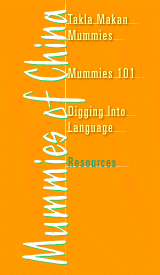|
|
|
|
 |
Resources | Books | Get Real Mummy Mania http://dsc.discovery.com/convergence/mummies/mummies.html At this extensive Discovery Channel Web site, learn about desert mummies, ice mummies, mummies of the mist, and more.Animal Mummies http://www.animalmummies.com Some ancient cultures turned their beloved pets into mummies, planning to take them along for the afterlife. Learn more at this Cairo Museum Web site.How Mummies Work http://science.howstuffworks.com/mummy.htm How Stuff Works offers an informative piece containing general information about the process of mummification in Egyptian history and elsewhere.Everything You Always Wanted To Know About Tocharian http://www.oxuscom.com/eyawtkat.htm A general history of the Tocharians and analysis of their language. Learn about the controversy surrounding their identity.The Silk Road Foundation http://www.silk-road.com/ Historical and cultural information about the Chinese communities of the "Silk Road"—the ancient highway built by the Tocharians. Books Nomads and the Outside World by A.M. Khazanov University of Wisconsin Press, 1994 Nomads of the Eurasian Steppes in the Early Iron Age Jeannine Davis-Kimball, Vladimir S. Bashilov, and Leonid T. Yablonsky, Eds. Zinat Press, 1995 Get Real Archaeological Fieldwork Opportunity with the Center for the Study of Eurasian Nomads http://www.csen.org/ CSEN accepts volunteers to participate in several types of research projects. In the past, the center has conducted archaeological excavations in southern Kazakhstan along the Tien Shan Mountains, on the Kazakhstan and Russian border in the southern Ural steppes, and in Moldova along the Dniester River. An ongoing research project involves the study of the nomadic societies living in southern Kazakhstan, western Mongolia, and western China. Occasionally a project will involve studying the collections in museums located in the former USSR countries. The archaeological and ethnographic sessions, usually divided into three-week periods, frequently begin in June and run through mid- to late- August. Museum studies may run as late as mid-October. The application deadline is four to six weeks before the beginning of the first session of a given research project. The minimum age for volunteers is 21. No experience is required, but participants must be in good health and able to withstand challenging field conditions, unusual foods, adverse weather and travelling situations. Takla Makan Mummies | Mummies 101 | Digging into Language Resources | Transcript | Mummies Home Editor's Picks | Previous Sites | Join Us/E-mail | TV/Web Schedule About NOVA | Teachers | Site Map | Shop | Jobs | Search | To print PBS Online | NOVA Online | WGBH © | Updated October 2000 |